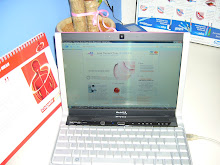Tuesday, March 10, 2009
Wow ... absent for so long!!
Methods of tooth whitening
Also take from Wikipedia: http://en.wikipedia.org/wiki/Tooth_whitening
There are two main methods of gel bleaching--one performed with high-concentration gel, and another with low-concentration agents. High-concentration bleaching can be accomplished either in the dental office, or at home. Performing the procedure at home is accomplished using high-concentration carbamide peroxide which is readily available online or in dental stores, and therefore is more cost-effective than the in-office procedure by many orders of magnitude. Whitening is performed by applying a high concentration of oxidizing agent to the teeth with thin plastic trays, for a short period of time, which produces quick results. The application trays ideally should be well-fitted to retain the bleaching gel, ensuring even and full tooth exposure to the gel. Trays will typically stay on the teeth for about 15-20 minutes. Trays are then removed and the procedure is repeated up to two more times. Most in-office bleaching procedures use a light-cured protective layer that is carefully painted on the gums and papilla (the tips of the gums between the teeth) in order to reduce the risk of chemical burns to the soft tissues. The bleaching agent is either carbamide peroxide, which breaks down in the mouth to form hydrogen peroxide, or hydrogen peroxide itself. The bleaching gel typically contains between 10-30% carbamide peroxide (15% is recommended) which is roughly equivalent to 3-10% hydrogen peroxide concentration.
Low-concentration whitening is far less effective, and is generally only performed at home. Low-concentration whitening involves purchasing a thin mouthguard or strip that holds a relatively low concentration of oxidizing agent next to the teeth for as long as several hours a day for a period of 5 to 14 days. Results can vary, depending on which application is chosen, with some people achieving whiter teeth in a few days, and others seeing very little results or no results at all. Whitening is potentially better at a dentist because the strip or mouth-guard does not completely conform to the shape of the teeth, sometimes leaving the tips of the teeth (near the gumline) unbleached. The bleaching agent is typically less than 10% hydrogen peroxide equivalent so irritation to the soft tissue around teeth is minimized. Dentists as well as some dental laboratories can fabricate custom fitted whitening trays that will greatly improve the results achieved with an over-the-counter whitening method.
A typical course of bleaching can produce dramatic improvements in the cosmetic appearance of most stained teeth however, some stains do not respond to bleaching. Tetracycline staining may require prolonged bleaching, as it takes longer for the bleach to reach the dentine layer. White-spot decalcifications may also be highlighted and become more noticeable. Bleaching is least effective if teeth have white spots, decay or infected gums. It is also least effective when the original tooth color is grayish. Bleaching is most effective with yellow discolored teeth.
Laser bleaching, also known as power bleaching, utilizes light energy to accelerate the process of bleaching in a dental office. Different types of energy can be used in this procedure. The ideal source of energy should be high energy to excite the peroxide molecules without overheating the pulp of the tooth, creating an inflammatory response.[2] The use of an argon laser to safely and effectively speed up the whitening process is ideal for laser bleaching. The use of an argon laser is preferred over the use of an arc lamp (the traditional dental method of light-activated bleaching) or infrared laser because it does not exhibit any of the heat or UV ray emissions of the arc lamp.[2] Chemical burns, which are occasionally a side-effect of gel bleaching, or heat-induced sensitivity, are not a factor with argon laser whitening.[2] Most laser teeth whitening treatments can be done in approximately 1 hour, in a single visit to a dental physician, (depending on the condition of a person’s teeth).
Whitening ... your million dollar smile!
Teeth whitening is becoming an increasingly popular cosmetic "treatment". Who doesn't want a winning smile? ... here is an interesting article for your reading (taken from Wikipedia):
http://en.wikipedia.org/wiki/Tooth_whitening
THANK YOU TO WIKIPEDIA FOR SUCH A PRECISED WRITE-UP:
Dental bleaching, also known as tooth whitening, is a common procedure in general dentistry but most especially in the field of cosmetic dentistry. A child's deciduous teeth are generally whiter than the adult teeth that follow. As a person ages the adult teeth often become darker due to changes in the mineral structure of the tooth, as the enamel becomes less porous. Teeth can also become stained by bacterial pigments, foodstuffs and tobacco. Certain antibiotic medications (like tetracycline) can also lead to teeth stains or a reduction in the brilliance of the enamel.
There are two methods to whiten teeth: bleaching gel and laser bleaching. Traditionally, at-home whitening is done with bleaching gel which is applied to the teeth using thin guard trays. Oxidizing agents such as hydrogen peroxide or carbamide peroxide are utilized to lighten the shade of the tooth. The oxidizing agent penetrates the porosities in the rod-like crystal structure of enamel and oxidizes interprismatic stain deposits; over a period of time, the dentin layer, lying underneath the enamel, is also bleached. Laser bleaching utilizes light energy to accelerate the process of bleaching in a dental office. The effects of bleaching can last for several months, but may vary depending on the lifestyle of the patient. Factors which will decrease whitening include smoking and the ingestion of dark colored liquids like coffee, tea and red wine.
Internal staining of dentin can discolor the teeth from inside out. Internal bleaching can remedy this. If heavy staining or tetracycline damage is present on a patient's teeth, and whitening is ineffective, there are other methods of whitening teeth. Bonding, when a thin coating of composite material is applied to the front of a person's teeth and then cured with a laser can be performed to mask the staining. A veneer can also mask tooth discoloration



